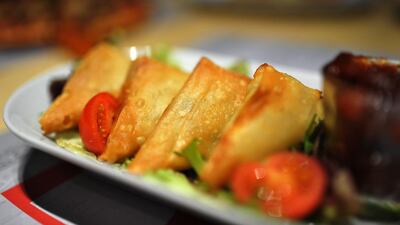During Ramadan many different dishes make their way on to dining tables of those observing the holy month.
Breaking of the fast is often a cultural affair that mixes family with a combination of flavours and menus.
Flaky, melt-in-the-mouth samosas, which seem to be a common treat – albeit with different stuffings and shapes in different parts of the world; and dishes like Tanzanian lamb with coconut and cassava are just a few of these.
Samosas
Conjure up an image of crisp, golden pastry that shatters pleasingly when bitten into, revealing a delicious, hot filling within. Imagine a gnawing hunger perhaps not entirely sated, but certainly appeased as the mouth fills with a welcome explosion of spiced flavour. The popularity of samosas on iftar tables is certainly not hard to understand.
Samosas don’t just appear alongside pakoras, chutneys, chick pea salads and paneer rolls at iftar in the homes of Indian and Pakistani Muslims. The appeal of these fried triangular treats is widespread, and they are enjoyed in varying forms – different shapes, alternative stuffings and a slight change in the spelling – across the Middle East and Africa. Given the birthplace of the snack, this is not really surprising: the samosa is believed to have originated in Persia, before traversing the ancient trade routes from Central Asia and eventually arriving in India.
There are a variety of traditional meat or vegetable stuffings: from minced lamb or mutton laced with chilli and garlic and spiced chicken, to spiced potatoes and mixed vegetables. Although it’s generally agreed that the difference between a samosa and the Emirati samboosa lies in a generous sprinkling of bezar spice mix, it is arguably the pastries oozing hot, molten cheese that are most loved by locals at iftar.
The versatility of the samosa certainly plays a role in its universal appeal. At home, they can be made entirely from scratch, dough, stuffing and all. Yet, they’re also very forgiving should you opt for a shortcut or two: shop-bought samosa pastry is a staple in the freezer section of UAE supermarkets, as are fully assembled, ready-to-cook varieties. Although usually deep-fried, samosas that are lightly brushed with oil and baked in the oven contain less calories and still taste fantastic.
The portability of this snack further adds to its allure – it can easily be picked up and eaten on the go, with no need for plates or cutlery. And although samosas are on iftar menus at plenty of high-end restaurants and hotels (no doubt accompanied by all manner of dipping sauces, chutneys and salads), this is street food at heart. If you wander through the older streets of Khalidiya in Abu Dhabi or Deira in Dubai, and allow your senses to guide you – follow the sound of hot oil spluttering and the smell of spices toasting – and you’re likely to stumble upon small, hole-in-the-wall restaurants where samosas are fried to order and can be purchased for just a few dirhams each.
Tanzanian lamb, coconut and cassava
“In Tanzania, we eat a lot of coconut-based dishes, particularly during Ramadan,” says Dubai-based Zaineb Maghji, who grew up in Dar es Salaam. “At iftar, we might have makai paka – fresh corn in coconut milk, mkatewa sinia – a rice and coconut cake that’s first cooked on the stove and then browned in the oven, as well as my favourite – cassava with lamb and chillies in a creamy coconut sauce.”
Also known as both mogo and yucca, cassava is a starchy root vegetable, which, thanks to being cheap and plentiful, is a staple ingredient in east Africa and is eaten daily – be it boiled with spices, grilled, fried until crisp to make chips and ground for flour. For important meals, or at special times of year such as Ramadan and Eid, cassava is treated more reverentially and cooked with lamb and chillies in a rich, creamy coconut sauce.
Traditionally, the lamb is marinated in garlic and ginger for several hours before being simmered in coconut milk with spices, boiled cassava and fresh chillies.
“When I was younger, I didn’t like lamb, so I’d refuse to eat that part,” says Maghji. “I loved the sweet-savoury chillies though; they were, and still are, the best part for me. Even though it’s a bit of a hassle to prepare, if you use freshly extracted coconut milk to make this dish, it tastes even better.”
While there are a plenty of African restaurants in both Dubai and Abu Dhabi, when you narrow the focus further and home in on Tanzanian food, the search becomes harder. For a taste of the country (although sadly not of lamb and cassava curry), Jambo’s Grill in Karama, Dubai, is a family-run restaurant that comes recommended by Tanzanian expats (insider tip: try the reasonably priced, crispy-crunchy cassava wedges with chilli).
artslife@thenational.ae

